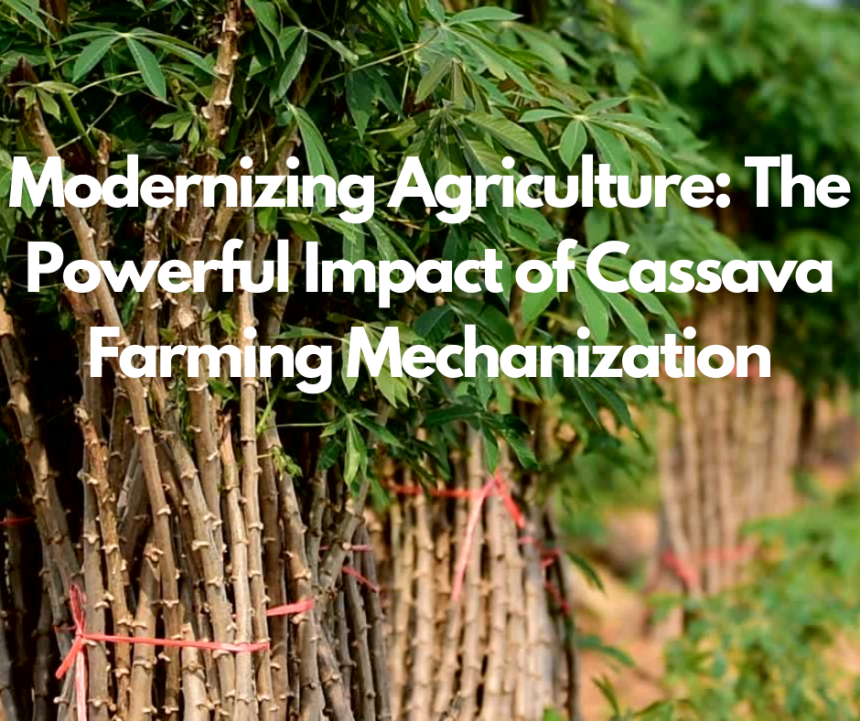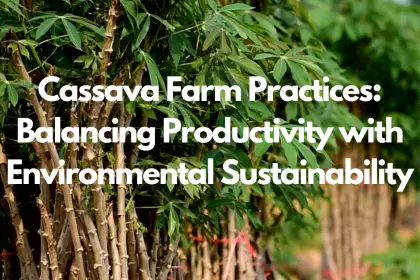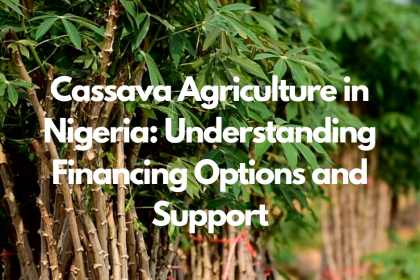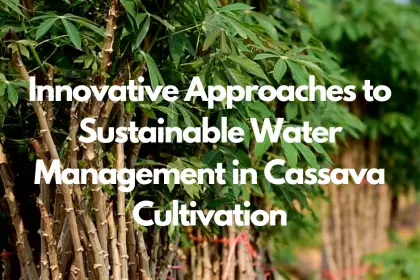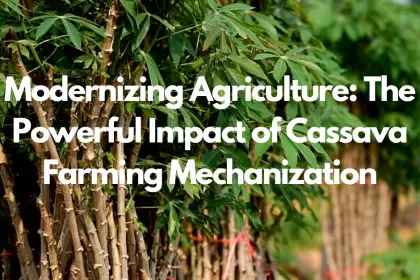Agricultural mechanization, particularly in the context of cassava farming, stands as a transformative force driving efficiency and sustainability in the global agribusiness sector. This shift not only promises enhanced production capabilities but also aligns with the broader objectives of feeding a growing planet. As developing countries, including Nigeria, increasingly embrace the mechanization of cassava farming, the potential for improved cost management, output value, and income generation becomes more apparent. This movement towards advanced agricultural practices signals a pivotal moment for nations striving to bolster their food security and economic resilience.
The discussion on the mechanization of cassava farming extends beyond the mere adoption of cutting-edge machinery—it encapsulates the challenges of modernization, the strides made thus far, and the vivid success stories emanating from regions like Nigeria. Through this article, readers will gain insights into the evolutionary journey of cassava farming, the tangible benefits mechanization brings to the table, the obstacles encountered in integrating sophisticated technologies, and a glimpse into the promising future that lies ahead. This narrative not only emphasizes the role of mechanization in revolutionizing cassava farming but also underscores its significance in shaping the landscape of global agribusiness.
The Evolution of Cassava Farming
Cassava, a staple crop with deep roots in agricultural history, has seen a transformative journey from its origins to becoming a cornerstone of food security in many parts of the world, particularly in Africa. The evolution of cassava farming is a testament to human ingenuity and adaptability, showcasing a blend of tradition and modernization that has shaped the agricultural landscape.
- Introduction and Spread
-
- 1558: Cassava was introduced to Burkina Faso from America by the Portuguese, marking the beginning of its journey in Africa. The variety known as Banfti was the first to be introduced.
- 16th Century: The crop was adopted across Africa, brought from Brazil by Portuguese traders, signifying a pivotal moment in the continent’s agricultural development.
- Modern Varieties: Over the years, improved varieties such as V5 (94/0270), Banké (V2), and KTMA, among others, have been developed and used alongside traditional varieties like manchien and santidougou, enhancing diversity and yield potential.
- Production and Research Advancements
-
- 1989: The launch of the Collaborative Study of Cassava in Africa (COSCA) aimed to analyze production and utilization trends, marking a significant step towards understanding and optimizing cassava farming.
- 1961-1999: A notable increase in cassava planted areas in Ghana and Nigeria, demonstrating the crop’s growing importance.
- Breeding and Agronomic Research: Efforts have led to high-yielding cultivars with an average yield increase from 13.0 t ha–1 in 1996 to 21.3 t ha–1 in 2016 in Asia, alongside the testing of remote sensing technologies for trait discovery.
- Archaeological Evidence of Domestication
-
- Evidence of manioc domestication, including starches and pollen grains, dates back to 6,000 years ago in the Amazon, with findings in north-central Colombia around 7,500 years ago.
- Pollen grains from cultivated cassava have been identified in archaeological sites in Belize and Mexico’s Gulf coast by 5,800–4,500 bp, offering a glimpse into the ancient origins of cassava cultivation.
This journey from ancient cultivation to modern-day agricultural practices highlights the significant role of cassava in sustaining populations and driving agricultural innovation. The mechanization of cassava farming in countries like Nigeria is a continuation of this evolutionary tale, promising to further elevate cassava’s status in the global agribusiness sector.
Key Benefits of Mechanization in Cassava Farming
Mechanization of cassava farming has ushered in a new era of agricultural productivity and efficiency, particularly noticeable in Nigeria, a country that has embraced these advancements wholeheartedly. The tangible benefits of mechanization are numerous, impacting various aspects of farming from yield to cost-effectiveness and beyond.
- Significant Increase in Yield:
-
- Before mechanization: 4-9 tons per hectare
- After mechanization: Up to 30 tons per hectare
This dramatic increase in yield is a testament to the efficiency of modern farming techniques, with project beneficiaries in Nigeria experiencing firsthand the transformative power of mechanization.
- Time and Cost Efficiency:
-
- Manual ploughing and harrowing: 10 days
- Mechanized operations: 3 hours
- Manual planting: 8 days
- Mechanized planting: 45 minutes
Furthermore, the net profit for mechanized farming stands significantly higher at 482,000 Naira, compared to 78,000 Naira for traditional farming methods. This not only highlights the time-saving aspect of mechanization but also its long-term financial benefits.
- Improvements in Quality of Life and Food Security:
-
- The Cassava Mechanisation and Agro-processing Project (CAMAP) in Nigeria has been a game-changer, resulting in a 200% increase in yields and a 100% increase in incomes for cassava farmers. This has not only improved the quality of life for these farmers but also attracted more women and youth into cassava farming as a viable business.
- Increased incomes from the sale of cassava products have soared from USD 150 – 600 per hectare to USD 2,000 –3,500 per hectare.
- Moreover, food security has been significantly enhanced, with yields per hectare jumping from 5 tonnes to between 25 – 45 tonnes.
The adoption of mechanization in cassava farming is a clear win for agribusiness, particularly in regions like Nigeria where these practices have taken root. The benefits extend beyond the immediate financial gains, fostering a more sustainable and efficient agricultural landscape that promises to support the growing global population.
Challenges in Adopting Mechanization
Despite the promising advancements in the mechanization of cassava farming, several challenges hinder its widespread adoption, particularly in regions like Nigeria. These obstacles not only impede progress but also affect the overall efficiency and productivity of the agricultural sector.
- Access to Machinery and Equipment: A fundamental barrier is the inadequate availability of agricultural machinery and equipment. This scarcity makes it challenging for farmers to fully embrace mechanized farming methods, which are essential for increasing cassava production and efficiency.
- Financial Constraints:
-
- Securing Loans: Farmers often face difficulty in securing loans for purchasing necessary agricultural machinery. The lack of financial support from institutions limits their capacity to invest in mechanization.
- Subsidies and Support: Recommendations include increasing subsidies to facilitate the purchase of agricultural machinery and promoting machinery suitable for cash crops like cassava. Enhancing the level of socialized agricultural services could also play a crucial role in overcoming financial hurdles.
- Infrastructure and Policy Challenges:
-
- Processing Facilities: The absence of processing facilities and related agro-industrial infrastructure significantly hampers the value addition and marketability of cassava products.
- Government Policies: Historical government policies that prioritized large-scale grain production over crops like cassava have contributed to a lag in cassava mechanization. Adjusting these policies to support cassava farming and mechanization is crucial for future development.
- Sustainable Mechanization: Sustainable agricultural mechanization strategies are essential for improving postharvest, processing, and marketing activities, thereby enhancing overall agricultural productivity.
- Health and Environmental Impacts:
-
- The effects of agricultural mechanization on farmers’ health vary by region and income level, with significant positive impacts observed in high-income and Tibetan areas. This underscores the need for targeted mechanization strategies that consider regional disparities and aim to improve farmers’ living conditions and environments.
The journey towards fully mechanized cassava farming is fraught with challenges, from financial and infrastructural barriers to policy and health considerations. Addressing these issues requires a multifaceted approach, involving increased financial support, infrastructure development, policy adjustments, and targeted mechanization strategies tailored to regional needs and conditions.
Case Studies of Successful Mechanization
In Nigeria, the journey towards the mechanization of cassava farming has been marked by significant advancements, thanks to the efforts of Engr. (Prof.) E. U. Odigboh and his team. They have developed a range of prototype machines tailored for the cassava production and processing chain. These include:
- Cassava planters
- Weeders
- Harvesters
- Peelers
- Graters
- Gari-mash pulverizer/sifter
- Gari frying machines
These innovations have been pivotal in streamlining the cassava farming process, from planting to processing, making it more efficient and less labor-intensive.
The Cassava Mechanisation and Agro-processing Project (CAMAP) in Nigeria stands as a beacon of success in the realm of cassava farming mechanization. This project has achieved remarkable milestones, including:
- Increased Cassava Production: Through the adoption of mechanized farming techniques, cassava production has seen a significant boost.
- Value Addition and Market Linkages: CAMAP has played a crucial role in adding value to the cassava industry by establishing market linkages, thereby enhancing the profitability of cassava farming.
- Capacity Building: A key focus of the project has been on building the capacity of local entrepreneurs. This involves training in the design, manufacture, maintenance, and repair of equipment essential for cassava planting, harvesting, and processing.
This holistic approach adopted by CAMAP not only enhances cassava production but also empowers local communities by fostering entrepreneurship in the agriculture sector.
In contrast, Malaysia’s experience with cassava production mechanization highlights the potential and challenges of fully mechanized cassava farming. The country has implemented mechanization in several stages of cassava production, such as:
- Land preparation
- Herbicide spraying
- Digging of roots
The possibility of achieving fully mechanized production on mineral soils is promising. However, factors such as rainfall and soil physical conditions play a critical role in determining the performance and economic viability of mechanized cassava farming in Malaysia. This case underscores the importance of considering environmental and climatic conditions in the mechanization process to ensure its success and sustainability.
Through these case studies, it’s evident that the mechanization of cassava farming holds immense potential for transforming agriculture. However, the journey is multifaceted, requiring attention to technological innovation, capacity building, and environmental considerations.
The Future of Mechanization in Cassava Farming
Cassava farming in Nigeria and other regions faces numerous challenges ranging from disease outbreaks to the impacts of climate change. However, the future of mechanization in cassava farming holds promising solutions to these issues, focusing on increasing efficiency, reducing labor dependency, and enhancing crop resilience.
- Disease and Pest Management:
-
- Innovative Mechanization Solutions: Development of machinery equipped with sensors for early detection of diseases such as mosaic disease and pests like mealybugs. This could significantly reduce the spread and impact of infestations.
- Genomic Tools Integration: The use of genomic selection and genome editing tools to develop cassava varieties that are more resistant to diseases and pests. This approach not only controls the spread but also stabilizes cassava prices for both domestic consumption and export.
- Addressing Climate Vulnerability:
-
- Climate-Resilient Farming Practices: Mechanization could include the development of irrigation systems that counteract unpredictable rainfall patterns, ensuring consistent crop growth even during droughts or excessive rainfall periods.
- Supply Chain and Infrastructure Development: Investments in robust supply chain infrastructure, including better warehousing and improved road networks, can reduce post-harvest losses. This is crucial for maintaining the quality and quantity of cassava, ensuring fair pricing for farmers.
- Market Access and Productivity:
-
- Technology and Innovation Integration: The adoption of contemporary processing technologies and the development of value-added cassava products can expand market reach and generate higher revenue. This includes mechanized planting and harvesting equipment tailored to Nigeria’s agro-ecological zones, improving adoption rates and effectiveness.
- Capacity Building and Accessibility: Governments and organizations facilitating access to mechanization through training, subsidies, or financing options can empower small-scale farmers, reducing their dependency on manual labor and enhancing productivity.
The future of cassava farming mechanization is not just about adopting new technologies but also about creating a sustainable ecosystem that addresses the current challenges while unlocking the potential for increased productivity and efficiency. Through strategic investments in research, development, and infrastructure, along with fostering collaboration among stakeholders, cassava farming can achieve significant advancements, contributing to food security and economic development in Nigeria and beyond.
FAQs
What impact does mechanization have on Nigeria’s agricultural sector?
Mechanization in Nigeria’s agriculture has significantly increased the amount of land cultivated, the yields of crops, and the income of farmers, with average increases of 2.34, 1.07, and 1.44 times, respectively.
How has agricultural mechanization evolved over time?
Agricultural mechanization began with the introduction of steam-powered reapers and traction engines. It has since progressed to include mobile hydraulics and electronic control systems, which are integral components of the modern agricultural machinery used today.
What obstacles do cassava farmers face?
Cassava farmers in Nigeria confront several challenges, including pest and disease control, obtaining quality planting materials, coping with weather variability, securing market access and dealing with price fluctuations, and managing the storage and transportation of the harvest.
What strategies can be implemented to enhance mechanization in Nigeria’s agriculture?
To improve farm mechanization in Nigeria, three main strategies are suggested: providing agricultural extension services to educate farmers on mechanization benefits, encouraging local production of farming machinery, and offering training for farm mechanization personnel.

